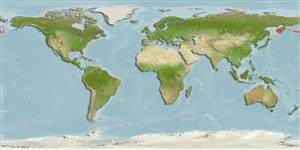Elasmobranchii (hajar och rockor) (sharks and rays) >
Rajiformes (Skates and rays) >
Arhynchobatidae (Softnose skates)
Etymology: Bathyraja: Greek, bathys = deep + Latin, raja, -ae = a ray (Raja sp) (Ref. 45335); maculata: Name from the Latin adjective 'maculata' meaning blotched, referring to the color markings on the dorsal side of the disc.
Environment: milieu / climate zone / djupintervall / distribution range
Ekologi
marina djupbottenlevande; djupintervall 70 - 1200 m (Ref. 131164), usually 400 - 700 m (Ref. 131164). Deep-water; 2°C - 6°C (Ref. 131164); 59°N - 51°N
North Pacific: southern Sea of Okhotsk to the eastern Gulf of Alaska, including the Bering Sea, the waters off the Kuril and Aleutian Islands, and eastern Kamchatka.
Length at first maturity / Size / Vikt / Age
Könsmognad: Lm 97.5, range 94 - 101 cm
Max length : 134 cm TL hane/ej könsbestämd; (Ref. 52075); publicerad maxvikt: 8.5 kg (Ref. 56527)
Short description
Bestämningsnycklar | Morfologi | Morfometri
This species is distinguished from its congeners Bathyraja in having a white blotches of different sizes on the dorsal surface of the disk, lateral folds of tail are broad; clasper has a large pseudosiphon; dense silky fibers covering egg capsule (Ref. 75535).
Body shape (shape guide): other.
Exhibited migratory pattern of going toward greater depths during colder months for overwintering, while in the warm period, this species predominantly fed at shallower depths Oviparous. Distinct pairing with embrace. Young may tend to follow large objects, such as their mother (Ref. 205). Eggs are oblong capsules with stiff pointed horns at the corners deposited in sandy or muddy flats (Ref. 205). Egg capsules are 10.19 cm long and 6.28 cm wide (Ref. 41249).
Life cycle and mating behavior
Könsmognad | Reproduktion | Lek | Ägg | Fecundity | Larver
Oviparous, paired eggs are laid. Embryos feed solely on yolk (Ref. 50449). Distinct pairing with embrace. Young may tend to follow large objects, such as their mother (Ref. 205).
McEachran, J.D. and K.A. Dunn, 1998. Phylogenetic analysis of skates, a morphologically conservative clade of elasmobranchs (Chondrichthyes: Rajidae). Copeia 1998(2):271-290. (Ref. 27314)
IUCN Red List Status (Ref. 130435: Version 2024-2)
Threat to humans
Harmless
Human uses
Fiskeri: bycatch
Verktyg
Special reports
Download XML
Internet-källor
Estimates based on models
Preferred temperature (Ref.
123201): 1.3 - 3.8, mean 2 °C (based on 27 cells).
Phylogenetic diversity index (Ref.
82804): PD
50 = 0.5000 [Uniqueness, from 0.5 = low to 2.0 = high].
Bayesian length-weight: a=0.00331 (0.00285 - 0.00385), b=3.10 (3.06 - 3.14), in cm total length, based on LWR estimates for this species (Ref.
93245).
Trofisk nivå (Ref.
69278): 4.1 ±0.71 se; based on food items.
Generation time: 30.5 ( na - na) years. Estimated as median ln(3)/K based on 1
growth studies.
Resiliens (Ref.
120179): Låg, lägsta populationsfördubblingstid 4,5-14 år (Fec assumed to be <100).
Fishing Vulnerability (Ref.
59153): Very high vulnerability (80 of 100).
🛈
